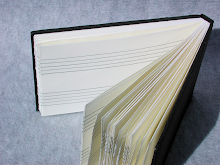 I'll start with the press. When I hear people lamenting over not having a press, one of my first comments is--Make one. Bookbinding is already about taking the long route to getting a book or journal, so why not dig the hole deeper. Books are about multiples whether it is duplication within the contents of a book or duplication of information between books. The press is also about duplication. So don't let not having a press be an obstacle. I'm mostly speaking to the people who have a print related idea but think they are stuck since they don't have a press.
I'll start with the press. When I hear people lamenting over not having a press, one of my first comments is--Make one. Bookbinding is already about taking the long route to getting a book or journal, so why not dig the hole deeper. Books are about multiples whether it is duplication within the contents of a book or duplication of information between books. The press is also about duplication. So don't let not having a press be an obstacle. I'm mostly speaking to the people who have a print related idea but think they are stuck since they don't have a press.I won't go too much into using a wooden spoon. I haven't had much luck with the technique (mostly because of my application), but do remember that it is an option.
The mechanics of the press is basically the idea that anything that will exert pressure can be used for printing to some degree of success. The photo in my article about adjusting photographs is a picture of several wood presses that work well for letterpress and block-type printing. Notice the resemblence to clamps?
To cover the actual construction and printing techniques would involve writing a book which is not my objective today. This is a primer. The internet is loaded with homemade printing press plans. All seem to be variations of similar ideas. One of the older how-to-build-an-improvised-press books is a Popular Mechanics book published in the 1960's (I think). I can picture where it was shelved in the universitiy's technical library, but I can't find it in the catalogue. Anyway, the technical library usually has something on improvised presses if the school has some sort of printmaking program. The key to remember is that for etching and litho printing some sort of roller or scraper bar needs to be incorporated into the press to concentrate the necessary pressure to transfer an image. Materials are easily found. Plywood, and standard hardware. The roller can be salvaged or found at tinkerer suppliers like American Science and Surplus (this store is a gem in and of itself).
When I began my quest to build a litho press, some printers told me it was impossible to build something out of wood that would create the required pressure. I remembered seeing one of Gutenberg's original presses, and it was made from wood. Sennefelder, the inventer of lithography, made a suitcase-sized, portable press made from wood. I was looking for a certain look when I built my press, so I used solid maple. If function is the only objective, plywood should work nicely--it's lighter weight too.
Pictured is my press and the resulting print. Everything is wood except for the leather on the scraper bar and the plexiglas for the tympan. The litho stone is local limestone from a landscaping supplier.

 A much simpler press can be built much more easily if function is the only concern. I took the extra trouble with this press to prove that it could be done.
A much simpler press can be built much more easily if function is the only concern. I took the extra trouble with this press to prove that it could be done.


No comments:
Post a Comment
Note: Only a member of this blog may post a comment.